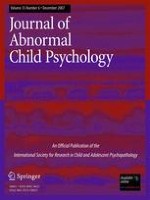01-12-2007
Person–Group Dissimilarity in Involvement in Bullying and Its Relation with Social Status
Gepubliceerd in: Research on Child and Adolescent Psychopathology | Uitgave 6/2007
Log in om toegang te krijgenAbstract
This study tested a person–group dissimilarity model for the relation between peer preference on the one hand, and bullying and victimization on the other. This model accounts for both individual and group (i.e., classroom) factors and postulates that children will be rejected by their peers when they display behaviors that deviate from the group norm. We tested the model in a sample of 2,578 early adolescents in 109 middle school classrooms. Multilevel analysis was used to account for our nested data when examining individual and group effects simultaneously in cross-level interaction terms. The results supported our hypotheses based on the dissimilarity model. Classroom norms of behavior appeared to affect the relation between involvement in bullying and peer preference, in that early adolescents who bullied were more likely to be rejected by their peers in a classroom where bullying was non-normative. In classrooms where bullying was normative, adolescents who bullied were less likely to be rejected or were even liked by their peers (i.e., positive scores on peer preference). The same was true for victimization, although victims still had low scores on peer preference even when victimization was normative. Theoretical and practical implications of these results are discussed in terms of directions for future research and intervention in bullying.
